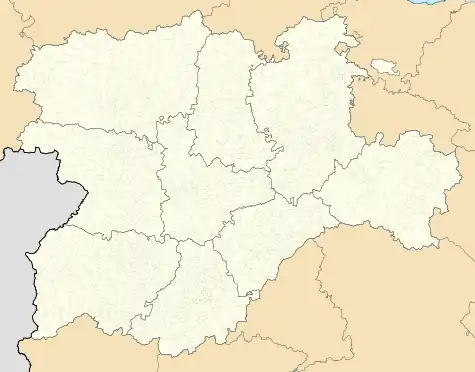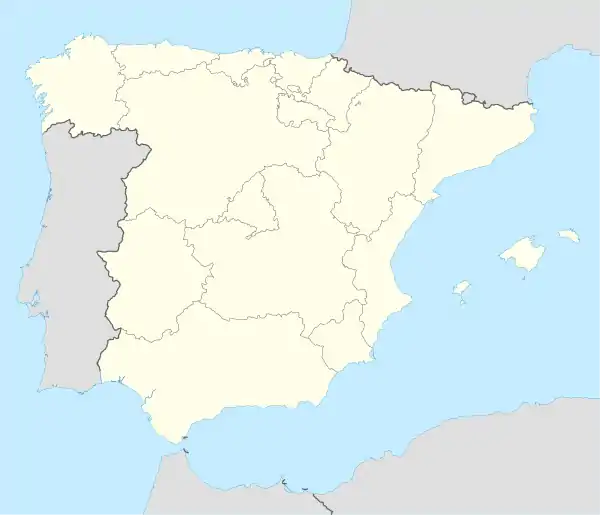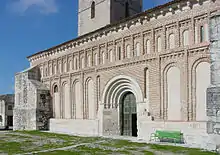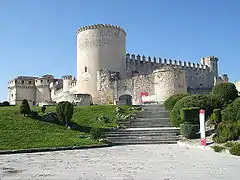Cuéllar
Cuéllar (Spanish pronunciation: [ˈkweʎaɾ]) is a municipality in the Province of Segovia, within the autonomous community of Castile and León, Spain.
Cuéllar | |
|---|---|
Town and Municipality | |
 Arch of San Basilio | |
 Flag  Seal | |
 Cuéllar Location in Spain.  Cuéllar Cuéllar (Spain) | |
| Coordinates: 41°24′3″N 4°18′49″W | |
| Country | |
| Autonomous community | |
| Province | |
| Municipality | Cuéllar |
| Elevation | 858 m (2,815 ft) |
| • Density | 27.89/km2 (72.2/sq mi) |
| Website | Official website |
The municipality had a population of 9,730 inhabitants according to the municipal register of inhabitants (INE) as of 1 January 2010, divided between 4,929 men and 4,801 women. This figure includes both the population of the municipal capital and that of the neighbourhoods and smaller local entities belonging to the municipality since 1981, divided as follows: Cuéllar (8 374), Arroyo de Cuéllar (381), Chatún (262), Campo de Cuéllar (221), Torregutiérrez (126), Dehesa Mayor (112), Lovingos (96), Escarabajosa de Cuéllar (79), Fuentes de Cuéllar (48) and Dehesa (31).[1]
Cuéllar is located on a hill. It is 60 km north-east of the capital city of Segovia and 50 km south of Valladolid. Cuéllar has an area of 272 square kilometres (105 sq mi), and it is 857 metres (2,812 ft) above sea level. The Cerquilla River and Cega River flow through the town. To the north, the town borders the municipality of Bahabón (the province of Valladolid); to the south, it borders Sanchonuño; to the east is Frumales, and to the west are San Cristóbal de Cuéllar and Vallelado.
Inhabitants of Cuéllar have a tradition of growing different crops and raising livestock. Some of these crops include cereals, vegetables, chicory, legumes, and beets. Livestock raised include pigs, sheep, and cows. Forestry and resin production were once important economic resources.
History
Medieval age
Professor Ubieto Arteta reported that there is some historical evidence of the existence of Cuéllar in the 10th century. Al-Mansur Ibn Abi Aamir (Spanish name: Almanzor) sacked the town and enslaved its population, deporting the citizens to Andalusia. King Alfonso VI of León and Castile rebuilt the town, bringing in new settlers at the end of the 11th century. This event was the origin of the municipality, which was ruled by its town council. In 1184, King Alfonso VIII of Castile assembled the parliament in Cuéllar.[2]
In the 13th century, Cuéllar was one of the most important towns in northern Spain, and the wool trade enriched the local economy. Many palaces and Mudéjar churches were constructed during this period. In 1256, Alfonso X of Castile granted Cuéllar a Royal Fuero. Queen María de Molina, Sancho IV of Castile's wife, inherited the town after the death of her husband. During her troubled regency, the town was a refuge while her son, the future King Ferdinand IV of Castile, was still a child.
In the middle of the 14th century, King Pedro I 'the Cruel' married Doña Juana de Castro in Cuéllar. The marriage was a fraud because the King was unlawfully divorced from his former wife and because he deserted Doña Juana after their wedding night.
In 1464, King Henry IV of Castile gave the town as a Lordship to his favorite nobleman, Beltrán de La Cueva, the first Duke of Alburquerque. Since then, the town was bound to this family. The duke's great-grandson was raised as a Marquess.[3]
Modern age
In the 17th century, the town suffered a recession, along with many cities and villages in the country. The monarchy moved to Madrid and settled the royal court within this city; therefore, the aristocracy had to relocate to Madrid. This time was also a period of poverty, due to the decadence of the wool trade, the taxes to pay for prior wars, and the various plagues that ravaged the country.[4]
In the 18th century, thanks to laws enacted by Charles III, the town recovered some of its social and economic prosperity.
When Napoleon invaded Spain, the town was looted by the French troops, who stole all the treasuries from the churches, monasteries, and the castle.
In 1833, the writer and politician Jose de Espronceda was exiled to Cuéllar because of his liberalism. Espronceda wrote the novel Sancho Saldaña o el Castellano de Cuéllar when he was living near the church of Santo Tomé.
20th century
During the Spanish Civil War, the town remained part of the country controlled by the nationalist forces, so its churches were preserved from any destruction. The Duke of Albuequrque's Castle served as headquarters to the fascist Italian troops, and later as a prison for different political prisoners. Many years after, the castle became a hospital for consumption patients and a jail for criminals. Now it is used as a high school and tourism center. Due to local agricultural production, the people of Cuéllar suffered fewer troubles after the civil war and did not emigrate as much as other people in the region.
Well-known people from Cuéllar
- Diego Velázquez de Cuéllar, Spanish conquistador.
- Bartolomé de la Cueva y Toledo, 16th century Roman Catholic cardinal.
- Juan de Grijalva, Spanish conquistador. Some authors say he originated from the same family as Diego Velázquez.
- Antonio de Herrera y Tordesillas, Spanish historian during the reigns of Philip II, Philip III, and Philip IV.
Architecture




- San Martín Church (Cuéllar) (Iglesia de San Martín): This is a church built in the Mudéjar style in the 14th century. The church is located near the Dukes of Alburquerque's castle. In 1997, a center for the interpretation of Mudéjar art was opened inside.
- San Andrés Church (Iglesia de San Andrés): There is historical evidence of its existence from 1277. During this period, it stood outside the walls of the town. This church is considered one of the most beautiful Mudéjar churches in Spain.
- San Esteban Church (Iglesia de San Esteban): This church stood between the first and second lines of the town walls. Its existence has been documented since 1247. The church apse is representative of the golden age of the Mudéjar art. An ancient burial ground was discovered next to this church.
- Santiago Church (Iglesia de Santiago): The apse is the only part of this Mudéjar church that survives to date. The temple has been documented since 1244. The records of the House of the Town Lineages, founded in the 14th century, were kept here.
- San Pedro Old Church (Antigua Iglesia de San Pedro): Dating back to 1095, this church was built on the south side of the town walls, and its shape appears to be more like a fortress. Some gothic structures remain in its tower and inside the structure. In the 19th century, the church had to be sold by order of the civil government. It was used as a flour factory for many years. Currently, the church continues to be owned as private property.
- Walls: The town walls were built in the medieval age, around the 12th century. They were enlarged and rebuilt in the 14th and 15th centuries for defense. The town walls are made of stone and lime, with noted arches along with them. The walls have two different parts: one for the ancient citadel and an outer wall. These walls have not remained unbroken because of the growth of the town, but there are several well-preserved sections besides the arches. In 1931, the walls were declared as national heritage sites.
- Dukes of Alburquerque's Castle: The ancient fortress was built before the 11th century, though the current building was built in the 14th and 15th centuries. In 1306, this structure became recognized as a castle and is located on a hilltop. It was restored and is currently used as a high school.
- School of Grammar (Estudio de Gramática): This was a Charity institution founded by Deacon Gómez González in 1424. It is believed that Cardinal Cisneros visited the school, but it is unknown if he was a student or a teacher. A Renaissance facade remains on the structure.
- Pedro I the Cruel's Palace: This gothic palace was built in the 14th century. In 1353, the king celebrated after marrying Doña Juana de Castro in the San Martin Church.
- Magdalena Hospital: Founded in 1429 by Deacon Gómez González, this gothic building was a charity hospital.
- San Francisco Park: This attractive park is surrounded by three old cloisters: Santa Isabel o Santa Ana, San Francisco, and The Immaculate Conception. Santa Isabel is expected to be restored. San Francisco was once the biggest temple in Cuéllar. It once contained the Duke's of Alburquerque's tombs (now located in The Hispanic Society of America Museum). This building had to be sold by order of the civil government and suffered a fire later where the building was nearly destroyed. Now the temple is used as a Center for the Running of the Bulls. The Immaculate Conception was built in the Baroque style. Currently, catholic nuns continue living in this religious building.
- El Salvador Church: This church has a Mudéjar apse with a flying buttress, which gives its singular shape.
- Santa Clara Cloister: The church has a renaissance facade and was one of the first gothic temples built in Cuéllar. Catholic nuns have been living here since the 13th century.
- Santa Maria in The Hill Church: Its elegant tower can be viewed from many places. It is believed that this church was built by the Templars, however, there is no recorded evidence.
- Santa Marina Tower: The tower was part of a former Mudéjar church and is constructed of brick.
- Santo Tomé Church: This church is a small gothic shrine.
- San Miguel Church: This church is located in the square of the town hall. It contains a mix of different building styles and has a gothic dome inside. The church houses a sculpture of Our Lady of the Rosary, which is the religious sponsor of the town.
- The yard in the town hall: This area is a small yard built in renaissance style.
- Ancient Trinity Cloister: The cloister is regretfully in a ruinous condition.
Festivals
- Children's Day: This festival is celebrated on New Year's Day. This event is an old tradition, consisting of a procession centered on the Child of The Ball. The child is accompanied by musicians and dancers, and all are dressed in 15th-century clothes. They march through the town and many people join them.
- Running of the Bulls: This festival is considered the oldest in Spain. It dates to 1215 when a request was written to forbid priests to run with the bulls, but it is believed that the pagan tradition started before the introduction of Christianity. The festival runs for five days, beginning on the last Saturday evening of August, and honors Our Lady of the Rosary. Early in the morning, the bulls run from the corral near the river 5 km away to the bull-ring. The bulls are guided by horsemen when they are in the pine-forest, and by the people when they arrive in the town. Parties and celebrations join the bull running, and many people come to enjoy the traditional dishes of roasted lamb and the regional wines.
- Annual Pilgrimage to the Sanctuary of Our Lady of the Hayfield (Nuestra Señora del Henar): Every September 17th, the devout people from the region come together to pray and celebrate. This sanctuary is 5 km away from Cuéllar, and it is a popular leisure place too.
References
- "Instituto Nacional de Estadística. (Spanish Statistical Institute)". www.ine.es. Retrieved 8 February 2021.
- Balbino Velasco Bayón (1974), Historia de Cuéllar, Diputación Provincial de Segovia, ISBN 978-84-500-6598-5
- Emilio Olmos Herguedas (1998), La comunidad de villa y tierra de Cuéllar a fines de la edad media: poder político concejil, ordenanzas municipales y regulación de la actividad económica, Secretariado de Publicaciones e Intercambio Científico, Universidad de Valladolid, ISBN 978-84-7762-855-2
- Balbino Velasco Bayón (1974), Historia de Cuéllar, Diputación Provincial de Segovia, ISBN 978-84-500-6598-5
External links
![]() Media related to Cuéllar at Wikimedia Commons
Media related to Cuéllar at Wikimedia Commons

